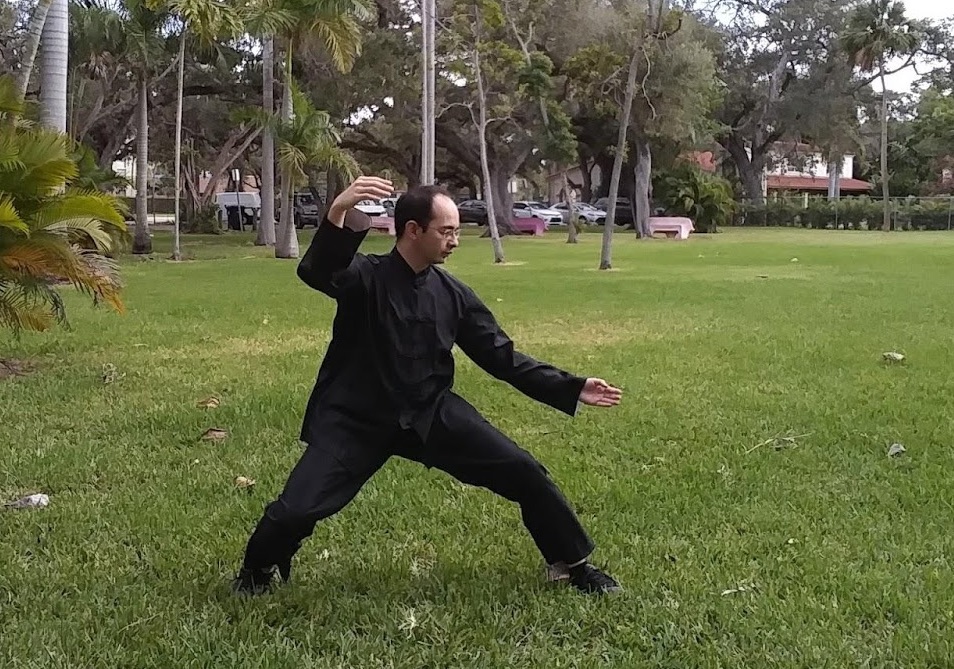BAGUAZHANG CIRCLE WALKING
Frederick Chu -- Shaolin Wabnam USA

Circle-Walking in Baguazhang
7. Circle Walking
Many books and videos exist on a variety of Baguazhang styles detailing each school's favored manner of Circle Walking [1, 3, 4, 8, 9, 10, 11, 20, 21, 22]. The importance of becoming an expert in a school's manner of Circle Walking cannot be understated: each school of Baguazhang practices its Circle Walking to most quickly obtain the force, skills, agility, speed, and other qualities they believe they need for effective fighting.
My first Baguazhang master, Sifu Wei Chung Lin [9], for example, after checking that my stances and basic footwork were up to par, taught me his mode of Circle Walking starting on my first day of lessons with him over the course of six months and told me to train them everyday without fail. Sifu Lin's mode of Circle Walking emphasized holding the upper body in a series of eight different postures, all aimed at developing what he termed different types of "energies", or types of force to use in combat.
One posture emphasized sinking force to press down powerfully on your opponent, for example. Another posture developed spreading force to open up an opponent's tightly locked defenses while simultaneously projecting power all the way from the upper back and shoulders to the fingertips. Sifu Lin found this exercise so important that I practiced this everyday for six months in order to build up agility, force, and flexibility before being taught my first combat application in his Yin Fu Baguazhang system.
While Sifu Lin did not call this exercise anything in particular, some other schools call this exercise Eight Postures Circle Walking [1] or Eight Internal Palms Circle Walking [17]. While some schools of Baguazhang will gloss over practicing Eight Internal Palms types of exercises, I personally found it, when combined with Black Tortoise training described below, to be the most powerful method of force training in my Baguazhang repertoire, exceeded only by advanced Shaolin force training such as Cosmos Palm (also known as Red Sand Palm).
8. Continuous Circle Walking
It is important to note that the Green Dragon Tests Claw posture in Circle Walking is relatively more flowing in terms of the energy developed compared to other patterns, and that flowing energy is far more forgiving and safer to develop than consolidated energy; hence, many schools will begin their Circle Walking training with Green Dragon Tests Claw to develop a foundation in flowing energy before moving on to focus that energy into harder force using other postures [17].
The manner in which a practitioner changes directions along the circle, how many times to walk in a certain direction, if the mind should be focused on this-or-that, and so forth are all dependent to one's particular school, aims, and objectives in training. Typically, beginning students are asked to focus on something, be it their center of gravity, their breathing, or some other mental anchor on which to build mental focus and discipline before eventually abandoning the anchor and allowing their mind to be free and clear, to develop mental clarity.
9. Walking the Circle in Stance Forms
Another variation of Circle Walking seen in many schools is pausing in between each step while walking along the circle for a period of time, called by some schools Walking the Circle in Stance Forms. Compared to continuously walking the circle, holding a posture for a period of time before moving onto the next step along the circle emphasizes and demands far more in terms of rooting, balance, sinking the body, and in energetic terms, sinking energy to the abdomen and consolidating energy into internal force across the entire body.
While beginning students might not be able to hold an appropriate posture for an extended period of time, be it Green Dragon Tests Claw or some other posture chosen by their master, a reasonable standard to aim for in the modern era is fifteen minutes for each "step" along the circle.
Intriguingly, this manner of practice is found in many other styles of martial arts. As one might expect, it is often found in other styles influenced by Wudang kung fu. The method is also found in schools of Praying Mantis where certain postures are held for a period of time to develop the strength, flexibility, and other qualities needed to become an effective fighter [17].
10. Black Tortoise Circle Walking
A curious and very rewarding mixture of the static and dynamic methods of Circle Walking is to walk along the circle in an extremely slow manner, to the point where every step along the circle can take many minutes of slow motion movement. I have not heard of a specific name for this manner of practice, though I have heard it unofficially termed "Doing Baguazhang like Taijiquan" [20] and, in the Shaolin and Wudang kung fu traditions, it is termed the "Black Tortoise" method of practice [17].
Perhaps one of the most well known practitioners of this manner of Circle Walking is a Nine Palaces Baguazhang master named Bai Yucai, who has several vignettes of his training found on YouTube [20]. My own experience in Baguazhang force training found this to be the most demanding exercise in my Baguazhang repertoire, with excellent benefits in mental clarity, discipline, rooting, and force developed not just at the palms and legs, but the entire body. For a time in my early training, I would only walk a single circle in each direction, with each circle starting at ten minutes and gradually being slowed down to spend one hour walking in each direction before completing my force training.

Walking in Stances
LINKS
